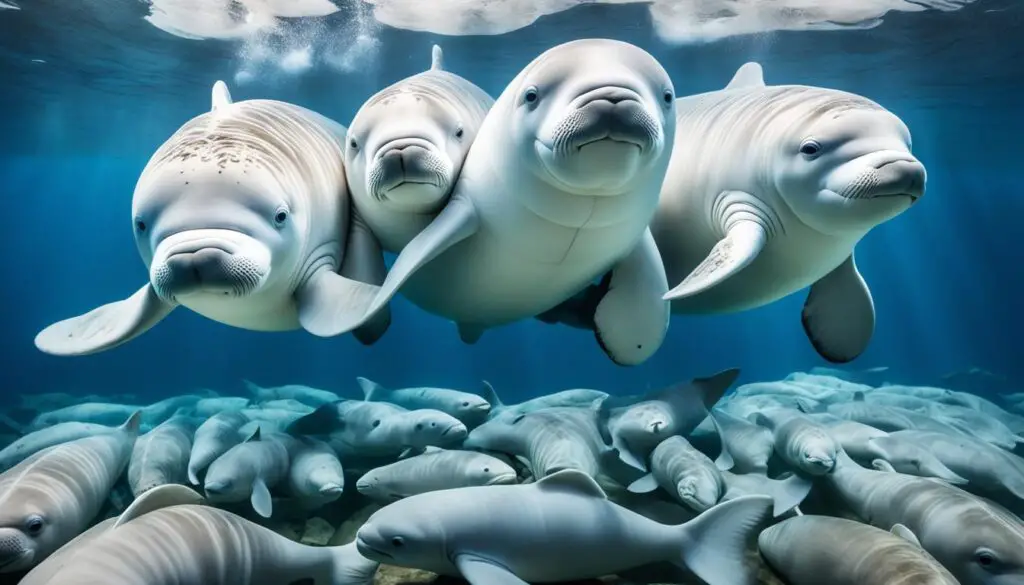Beluga whales have special ways of sleeping that help them in the cold Arctic waters. You might ask, how do they sleep and stay alert at the same time? They need to be ready to defend themselves and breathe air. Let’s dive into how they sleep and the unique ways they rest in the water.
Understanding Beluga Whale Sleep Patterns
Beluga whales have unique sleep habits that make them stand out. They sleep with only half their brain at a time, keeping the other half awake. This way, they can still swim and breathe even when they’re partly asleep.
Their sleep habits change with the environment, like light and where they live. Beluga whale sleep research shows they sleep more in dark places. They adjust their sleep based on how much light is around.
Learning about how beluga whales sleep shows how they adapt to their world. They can rest and stay alert at the same time, helping them survive in the wild. More research could teach us a lot about marine mammals.
| Aspect | Detail |
|---|---|
| Sleep Type | Unihemispheric slow-wave sleep (USWS) |
| Awareness Level | One hemisphere of the brain remains alert |
| Influencing Factors | Light, environmental conditions |
| Activity During Sleep | Surfacing intermittently for air |
Beluga Whale Rest Behavior
Beluga whales have interesting ways to rest that save energy and strengthen their social ties. They often float at the surface, looking like logs, in a behavior called logging. This lets them breathe slowly and relax deeply.
In places like aquariums, belugas can change how they rest. They might rest at the pool’s bottom. This shows how they can adjust their rest habits to fit their surroundings.
Belugas live in groups, or pods, which helps them stay safe while they rest. This group watchfulness protects them from dangers. It shows how important their social connections are for resting.
How do beluga whales sleep?
Beluga whales sleep in a way that’s unique to marine mammals. They have a special way of resting that’s different from what land animals do. This special sleep cycle helps them rest while staying alert to their surroundings.
Unihemispheric Slow Wave Sleep (USWS)
Beluga whales mainly sleep with a type called unihemispheric slow wave sleep (USWS). This means one half of their brain sleeps while the other half stays awake. This way, they can watch for dangers even when they’re sleeping. It’s very important in their Arctic home, where predators could be lurking.
Surface Breathing During Sleep
While sleeping, beluga whales can come up to the surface to breathe without fully waking up. They lift their blowhole out of the water during this unihemispheric slow wave sleep. This lets them breathe while still resting. It’s a key part of how they survive in their tough environment.

Beluga Whale Sleeping Habits
Beluga whales have unique ways to sleep in the water. They use a behavior called “logging.” In this, they stay afloat at the surface, rest for a long time, and breathe slowly. This helps them save energy and stay alert for dangers.
Logging Behavior
Logging is important for beluga whales. It helps them rest and stay connected with their group. When they rest together, they watch over each other. This shows how strong their social bonds are, even when they’re sleeping.
Resting Positions in the Water
Beluga whales also rest in different ways. They often lie on their sides or partially in the water. This helps them save energy and get air easily. These positions are key to their sleeping habits, helping them live in cold waters and stay together as a group. Their ability to adapt shows how resilient they are.
FAQ
How do beluga whales sleep?
Beluga whales sleep in a special way called unihemispheric slow-wave sleep (USWS). This means one half of their brain sleeps while the other half stays awake. This helps them stay alert and breathe while they swim and come up for air.
What are the sleeping habits of beluga whales?
Beluga whales sleep in ways like “logging,” where they float on the water’s surface and breathe slowly. They also rest in different positions, like lying on their sides or being partly underwater. This helps them save energy and easily get air.
Do beluga whales have a specific sleep cycle?
Yes, they have a sleep cycle that includes unihemispheric slow-wave sleep. This lets them breathe by keeping their blowhole above water while resting. Their sleep can change based on things like light and disturbances around them.
Are beluga whales active during the night?
Beluga whales are active at night, doing things like socializing and hunting. They sleep in a way that keeps them alert for predators. So, they might rest but still be ready to respond at night.
How do environmental factors affect beluga whale sleep?
Things like light and the environment change how beluga whales sleep. For example, in the Arctic summer with long days, their sleep patterns might change. This shows how they adapt to their surroundings.
What is the significance of social structure related to sleeping in beluga whales?
Beluga whales sleep in groups, which is important for their rest. Being in pods gives them safety and company while they sleep. It also helps them stay alert for predators and keep their social ties strong.







